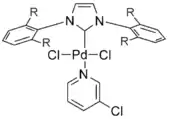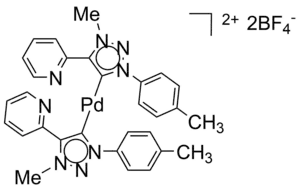PEPPSI
PEPPSI is an abbreviation for pyridine-enhanced precatalyst preparation stabilization and initiation. It refers to a group of palladium catalysts developed around 2005 by Prof. Michael G. Organ and co-workers at York University,[1][2] which can accelerate various aminations and cross-coupling reactions. In comparison to many alternative palladium catalysts, PEPPSI-type complexes are stable to air and moisture and are relatively easy to synthesize and handle.

Structure and synthesis
In the basic structure of PEPPSI, R can be a methyl (CH3, Me), ethyl (C2H5, Et), isopropyl (C3H7, iPr), isopentyl (C5H11, iPent), or isoheptyl (C7H15, iHept) group, and the resulting catalysts are thus labeled as PEPPSI-IMes, PEPPSI-IEt, PEPPSI-IPr, PEPPSI-IPent, and PEPPSI-IHept respectively, with or without "Pd-" added in front.[3] Contrary to common palladium-based catalysts, such as tetrakis(triphenylphosphine)palladium(0), PEPPSI is stable to exposure to air[4] and moisture.[5] Even heating in dimethyl sulfoxide at 120 °C for hours does not result in significant decomposition or neutralization of PEPPSI catalysts.[6]
The synthesis and structure of PEPPSI catalysts were presented in 2005[1][6] and published in 2006.[7][8] PEPPSI catalysts are organopalladium complexes containing N-heterocyclic carbene (NHC) ligands. They can be obtained by reacting an imidazolium salt, palladium(II) chloride, and potassium carbonate in 3-chloropyridine as a solvent, under vigorous stirring at 80 °C for 16 hours in air. The yield of PEPPSI in this reaction is 97–98%.[6][8]
iPEPPSI
Examples of abnormal NHCs based on the mesoionic 1,2,3-triazol-5-ylidene structure have been used for palladium catalysis. In this manner, pyridine fused tzNHCs were prepared to yield palladium complexes with pyridine attached to the carbene core. With this ligand, air stable and highly active palladium complexes of iPEPPSI (as in internal PEPPSI) were synthesized.[9]

Properties and applications
PEPPSI can catalyze various palladium cross-coupling reactions including Negishi coupling,[4] Suzuki coupling, Sonogashira coupling, Kumada coupling,[10] and the Buchwald–Hartwig amination as well as the Heck reaction.[6][11] In Negishi coupling, PEPPSI promotes reaction of alkyl halides, aryl halides or alkyl sulfonates with alkylzinc halides,[12] and the important advantage of PEPPSI over alternative catalysts is that the reaction can be carried out in a general chemical laboratory, without a glove box. PEPPSI contains palladium in the +2 oxidation state and is thus a "precatalyst", that is the metal must be reduced to the active Pd(0) form in order to enter the cross-coupling catalytic cycle. This is usually achieved in situ in the presence of active transmetalating agents such as organo-magnesium, -zinc, -tin, or -boron reagents.[3] Once activated, the NHC-Pd(0) species becomes rather air-sensitive.[4][13][14]

An efficient, cationic palladium catalyst of iPEPPSI (internal PEPPSI) type was demonstrated to efficiently catalyse the copper-free Sonogashira reaction in water as the only solvent, under aerobic conditions, in the absence of copper, amines, phosphines and other additives.[9]

References
- Organ, M. G. Rational catalyst design and its application in sp3-sp3 couplings. Presented at the 230th National Meeting of the American Chemical Society, Washington, DC, 2005; Abstract 308.
- Hadei, Niloufar; Kantchev, Eric Assen B.; O'Brie, Christopher J.; Organ, Michael G. (2005). "The First Negishi Cross-Coupling Reaction of Two Alkyl Centers Utilizing a Pd−N-Heterocyclic Carbene (NHC) Catalyst†". Organic Letters. 7 (17): 3805–7. doi:10.1021/ol0514909. PMID 16092880.
- Nasielski, Joanna; Hadei, Nilofaur; Achonduh, George; Kantchev, Eric Assen B.; O'Brien, Christopher J.; Lough, Alan; Organ, Michael G. (2010). "Structure-Activity Relationship Analysis of Pd-PEPPSI Complexes in Cross-Couplings: A Close Inspection of the Catalytic Cycle and the Precatalyst Activation Model". Chemistry: A European Journal. 16 (35): 10844–53. doi:10.1002/chem.201000138. PMID 20665575.
- Jie Jack Li, E. J. Corey Name reactions for homologations, Part 1, John Wiley and Sons, 2009, ISBN 0-470-08507-X p. 74
- Valente, Cory; Belowich, Matthew E.; Hadei, Niloufar; Organ, Michael G. (2010). "Pd-PEPPSI Complexes and the Negishi Reaction". European Journal of Organic Chemistry: n/a. doi:10.1002/ejoc.201000359.
- PEPPSI Catalysts, Sigma Aldrich
- Issue cover of Chemistry: A European Journal, June 2006
- O'Brien, Christopher J.; Kantchev, Eric Assen B.; Valente, Cory; Hadei, Niloufar; Chass, Gregory A.; Lough, Alan; Hopkinson, Alan C.; Organ, Michael G. (2006). "Easily Prepared Air- and Moisture-Stable Pd–NHC (NHC=N-Heterocyclic Carbene) Complexes: A Reliable, User-Friendly, Highly Active Palladium Precatalyst for the Suzuki–Miyaura Reaction". Chemistry: A European Journal. 12 (18): 4743–8. doi:10.1002/chem.200600251. PMID 16568494.
- Gazvoda, M.; Virant, M; Pevec, A.; Urankar, D.; Bolje, A.; Kočevar, M.; Košmrlj, J. (2016), "A mesoionic bis(Py-tzNHC) palladium(II) complex catalyses green Sonogashira reaction through an unprecedented mechanism", Chem. Commun., 52 (8): 1571–1574, doi:10.1039/c5cc08717a, PMID 26575368
- Lutz Ackermann Modern arylation methods, Wiley-VCH, 2009, ISBN 3-527-31937-9 p. 52
- S. V. Luis, Eduardo García-Verdugo Chemical Reactions and Processes Under Flow Conditions, Royal Society of Chemistry, 2010, ISBN 0-85404-192-3 p. 153
- Catherine S. J. Cazin Heterocyclic Carbenes in Transition Metal Catalysis and Organocatalysis, Springer, 2010, ISBN 90-481-2865-X pp. 169–173
- Organ, MG; Avola, S; Dubovyk, I; Hadei, N; Kantchev, EA; O'Brien, CJ; Valente, C (2006). "A User-Friendly, All-Purpose Pd–NHC (NHC=N-Heterocyclic Carbene) Precatalyst for the Negishi Reaction: A Step Towards a Universal Cross-Coupling Catalyst". Chemistry: A European Journal. 12 (18): 4749–55. doi:10.1002/chem.200600206. PMID 16568493.
- PEPPSI: Instructions for Use, Sigma-Aldrich